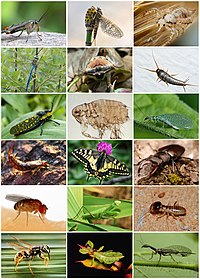
Photo from wikipedia
Abstract Recent studies have documented global declines in insects and their relatives, but the exact mechanisms explaining these patterns are not fully understood. A potential driver underlying arthropod population declines… Click to show full abstract
Abstract Recent studies have documented global declines in insects and their relatives, but the exact mechanisms explaining these patterns are not fully understood. A potential driver underlying arthropod population declines is increases in anthropogenic inputs of nitrogen (N) and phosphorus (P). Here, we synthesize the effects of N, P, and combined N + P enrichment on the abundance of hexapods (insects and collembola) and arachnids from 901 experiments reported in 84 studies. We found that N and combined N + P enrichment caused significant decreases in the abundance of these groups overall. While arthropod responses to nutrient enrichment across aquatic and terrestrial habitats and in temperate as well as tropical climatic zones differed in magnitude, our results suggest that arthropods are decreasing similarly in response to nitrogen and phosphorus enrichment. Further, despite previously shown differences in the nutrient demands of different insect metamorphosis groups, we found consistent negative effects of N + P enrichment on all groups. Our results also showed that the negative effects of nutrient additions are stronger for aquatic insects that are considered more sensitive to changes in physical–chemical parameters in their environments, Ephemeroptera, Plecoptera, and Trichoptera (EPT), compared with other aquatic insects. In addition, N + P enrichment reduced the abundance of above‐ground and below‐ground arthropods, suggesting that a similar mechanism driving arthropod community change is acting on both groups. These findings suggest that changes in elemental cycles are a potential cause of the ongoing global decline of arthropods and underscore the serious effects of nutrient enrichment on ecological systems.
Journal Title: Ecology
Year Published: 2022
Link to full text (if available)
Share on Social Media: Sign Up to like & get
recommendations!